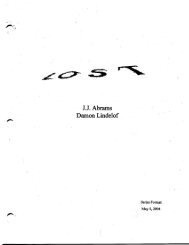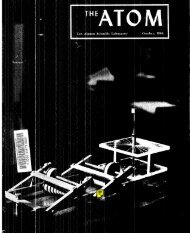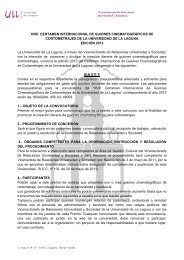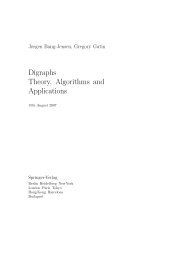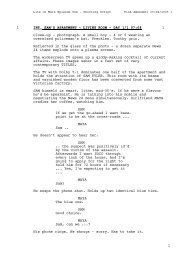Create successful ePaper yourself
Turn your PDF publications into a flip-book with our unique Google optimized e-Paper software.
ANSWERS,<br />
H INTS &<br />
SOLUTIONS<br />
tUIallt<br />
M1 16<br />
Let n be the number of sides of<br />
the given polygon iof course, n >- 1\.<br />
Then the number of rts diagonals is<br />
n(n - 3ll2 (because there are n - 3<br />
diagonals issuing irom each oi its n<br />
vertices, and this accounrs tr,r'ice for<br />
each diagonal). So rre har.e to prove<br />
that<br />
sd<br />
n n(n- 3r I<br />
where s and d are the sums o{ the<br />
iengths of all the pol,vgon's sides and<br />
diagonals, respectir.elr-.<br />
Consider two nonadiacent sides<br />
AB and CD, and dragonals AC and<br />
BD joining their endpoints and intersecting<br />
at O 1iig. 1J. Since AB <<br />
AO + OB, CD < CO + OD, we have<br />
AB + CD. iAO + OC) + IBO + OD)<br />
=AC+BD.<br />
I{ u,e write out such inequalities<br />
{or all pairs of nonadjacent sides and<br />
add them up, we'l1 get (n - 3)s on the<br />
le{t side (because each side enters r<br />
- 3 pairs) andZd on the right side (because<br />
each diagonal occurs in two<br />
inequalities-it joins two pairs of<br />
nonadjacent sides in the position of<br />
figure 1). So (n - 3)s . 2d, which is<br />
equivalent to what we set out to<br />
prove.<br />
Figure 1<br />
M1 17<br />
The answer isl-t. Consider any<br />
of the permutations in question. Suppose<br />
the number in the first place<br />
(from the left) is k. If k > 1, then the<br />
numbersk - l, k - 2,..., 1 will be met<br />
just in this (decreasing) order as we<br />
move from left to right. Indeed, the<br />
number 1 must have 2 on its left side,<br />
the number 2 must have 1 or 3-that<br />
is, 3--on the left, 3 must have} or 4-<br />
that is, 4-on the left, and so on.<br />
Similarly, for k < n the numbers k + 1,<br />
k + 2, ..., n must be arranged in increasing<br />
order, becausen - 1 must be<br />
to the left of n, then n - 2 to the left<br />
of n - I, and so on. Therefore, arty of.<br />
the permutations considered in the<br />
problem is uniquely determined by<br />
the set of places occupied by the<br />
numbers l, 2, ...,k - 1 (there may be<br />
no such places if k = l-that is, for<br />
the identity permutation 1,2, ..., nl:<br />
we have to affange these numbers in<br />
these places in decreasing order and<br />
the remaining numbers in the remaining<br />
places in increasing order.<br />
It's not hard to see that the number<br />
of such sets is simply the number<br />
of all subsets of the set of all the<br />
n - 1 places except the first, and is<br />
equal to 2" - I.<br />
Ml18<br />
We'Il use induction overm + fl to<br />
prove a slightly generalized statement<br />
with not Tess than k greatest<br />
numbers underlined in each column,<br />
andnot less thanl in each row<br />
(this will be more convenient for<br />
inductive reasoning).<br />
Obviously, for m = n : k : I = I<br />
the statement is true: ftJ: 1 number<br />
(the only one) will be underlined<br />
twice. Let's now show that the<br />
statement for an m x n afiay can be<br />
reduced to the case of an lm - Il x n<br />
ormx(n-llaruay.<br />
If all the underlined numbers in an<br />
m x n afiay are underlined twice, then<br />
there are no less thankJ of them. Otherwise,<br />
let a be the greatest of the<br />
numbers underlined once. It's either<br />
one of the k greatest numbers in its<br />
column or one of the I greatest numbers<br />
in its row. Assume it was underlined<br />
"along a column." Then the 1<br />
greatest numbers in its row are<br />
greater than a and so are underlined<br />
twice. Cancel out this row. We get an<br />
(m - ll x n arrayt in which at least 1<br />
greatest numbers are underlined in<br />
each line and at least k - 1 numbers<br />
in each column. The induction hypothesis<br />
implies that at least (k - 1)1<br />
numbers in this reduced afiay are<br />
underlined twice. The same numbers<br />
are underlined twice in the big array;<br />
together with at least I numbers<br />
underlined twice in the line that was<br />
deleted, this makes at least (k - lll + 1 :<br />
ld numbers, completing the proof.<br />
Ml19<br />
Let's first prove that PAr = PA2 =<br />
... : PAn.Suppose this is not true.<br />
Choose the shortest and the longest<br />
of these edges, PA, and PAr, respectively.<br />
Now draw atangleBAC congruent<br />
to angles PA.A,, ..., PAnAt,<br />
and mark off the segmentAB : ArA,<br />
: . . . = A,lron one of its sides, and segments<br />
AC = Ar_rP and AD = Aj_P<br />
on the other side. (Figure 2 shows the<br />
Figure 2<br />
IUllllIU[l/il'lSlItRS, lllilIS & S0LUIl0ll $<br />
4$



